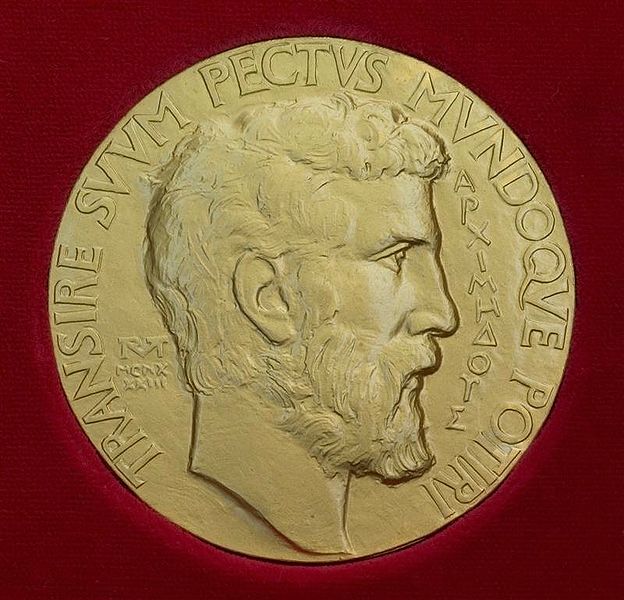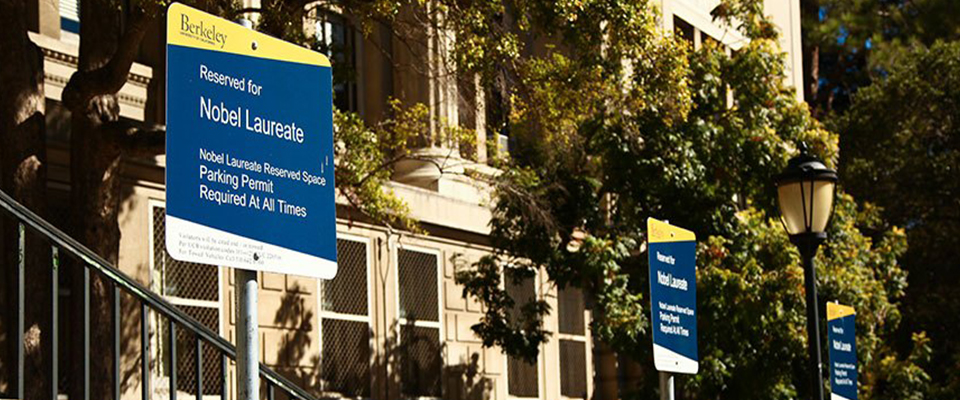On April 13, 1888, Swedish industrialist Alfred Nobel, the inventor of dynamite, who made millions turning his invention into munitions and selling them to the armies of the world, was aghast to read a story in a Paris newspaper that mistakenly reported his death.
It was actually his older brother, Ludvig, who had died, but Alfred was horrified by the headline: “The merchant of death is dead.”
The story went on to say, “Dr. Alfred Nobel, who became rich by finding ways to kill more people faster than ever, died yesterday.”
Appalled by the thought that this is the way he would be remembered, Nobel resolved to salvage his reputation by bequeathing his fortune to fund prizes for people “who, during the preceding year, shall have conferred the greatest benefit to mankind” in five different fields: physics, chemistry, literature, medicine or physiology, and peace. The only restriction was that the winner (or winners) must still be alive.
The first Nobel Prizes, awarded in 1901, consisted of a gold medal with Nobel’s picture on it, a diploma, and a monetary award roughly equivalent in value to the $1,150,000 awarded today. (When there are multiple winners for the same achievement, which often happens in the sciences, each one gets a medal, and they split the money.)
Twenty-three Cal professors have won Nobel Prizes, including Glenn Seaborg (Chemistry 1951), George Akerlof (Economics 2001), George Smoot (Physics 2006) and Randy Schekman (Physiology or Medicine, 2013), along with 30 alumni. Most recently, Barry Barish ’57 and ‘62, was awarded the 2017 Nobel Prize in Physics.
But what about other fields of human endeavor? Do they have “best of” prizes, too? Yes indeed, many of them described as “The Nobel Prize of _________.” With the Nobel season now past, we’re surveying this field of alternative Nobels, with special attention to Berkeley recipients.

The self-styled “Nobel Prize of mathematics” is the Fields Medal, named after Canadian mathematician John Charles Fields. It’s awarded once every four years and pays a lot less than the Nobel Prize: only around $13,700. And it has different rules: Only people under 40 are eligible because the purpose is to encourage younger mathematicians. The youngest was Jean-Pierre Serre of the Nancy University in France, who was only 27 when he won in 1954. Three UC Berkeley professors have won the Fields Medal: Stephen Smale (1966), Vaughan F.R. Jones (1990), and Richard Borcherds (1998).
The medal depicts the ancient mathematician Archimedes and, ironically, contains a mathematical error: Instead of “MCMXXXIII,” which means 1933 in Latin, it says, “MCNXXXIII,” which means nothing.
The “Nobel Prize of computer science” is the Turing Award, named after the brilliant British mathematician Alan Turing, the founder of theoretical computer science and artificial intelligence, who helped win World War II by building the world’s first computers to crack German’s super-secret Enigma code.
The Turing Award is a hefty $1 million and is given every year to someone who has made “lasting and major technical contributions to the computer field.” Note the emphasis on “technical,” which means you won’t find Steve Jobs or Bill Gates among the winners, as their talent was in marketing and design. The winners are a long list of people you’ve probably never heard of but whose influence on your life has been profound; for instance, this year’s awardee is Englishman Tim Berners-Lee (aka Sir Timothy John Berners-Lee OM KBE FRS FREng FRSA FBCS), who is credited with inventing the World Wide Web. UC Berkeley has 23 Turing Award winners, more than any other institution, including the late Douglas Englebart (1997), inventor of the computer mouse, and Richard Karp (1985), current director of the Simons Center for Theoretical Computing.
Karp was also the recipient of a Kyoto Prize (2008) from Japan, another award that rivals the Nobel for prestige if not in cash, at 50 million Yen, or about $450,000. This year, the award in the Arts and Philosophy category went to UC Berkeley musicologist, Richard Taruskin.
The Nobel Prize of geology is the Vetlesen Prize, established in 1959 “for scientific achievement resulting in a clearer understanding of the Earth, its history, or its relations to the universe.” Cal professor Walter Alvarez, the person who figured out that the dinosaurs were probably killed by an asteroid, won the Vetlesen Prize in 2008, forty years after his father, Luis Alvarez, another Cal professor, won the Nobel Prize in Physics.
A recent arrival on the prize scene is the Breakthrough Prize, founded in 2012 to honor outstanding contributions in Life Sciences, Fundamental Physics, and Mathematics. Funded partially by Mark Zuckerberg, it may not be as old as the Nobel, but it comes with an impressive chunk of cash: $3 million to each winner. Among the winners so far: Jennifer Doudna, Professor of Chemistry and of Molecular and Cell Biology at Cal’s Department of Chemistry and Chemical Engineering, and cancer researcher James Allison, for his discovery of T cell checkpoint blockade as effective cancer therapy during his time at the Cal Cancer Research Center.
Jakob von Uexkull established the Right Livelihood Awards after the Nobel Committee turned down repeated requests to add prizes in environmental protection, sustainable development, and human rights to the traditional five categories.
The Goldman Environmental Prize, often called “the Green Nobel,” honors grassroots environmental activists “for sustained and significant efforts to protect and enhance the natural environment, often at great personal risk.” Founded by Richard and Rhoda Goldman on Earth Day 1990, six prizes, each worth $150,000, are awarded every year to environmental activists, each from a different continent, who mostly toil in relative obscurity under the radar of the mainstream media.
In 2010 Richard Goldman, who graduated from Cal in 1941 and co-founded the University’s Goldman School of Public Policy with his wife Rhoda in 1997, was named Alumnus of the Year by the Cal Alumni Association–widely considered the Nobel of alumni awards.
Ahem.
The Right Livelihood Award, which is called “the alternative Nobel Prize,” was established in 1980 by Swedish industrialist (the Swedes just love these things, don’t they?) Jakob von Uexkull to “honor and support those offering practical and exemplary answers to the most urgent challenges facing us today.” They are awarded in Stockholm, the same city where the Nobels are given out (except for the Peace Prize, which is presented in Oslo) on the day before the Nobel ceremony, and they are generally understood to be a critique of the Nobel Prizes. Von Uexkull established them after the Nobel Committee turned down repeated requests to add prizes in environmental protection, sustainable development, and human rights to the traditional five categories.
Among the winners are longtime Berkeley resident Daniel Ellsberg (2005) and Chilean economist Manfred Max-Neef, who taught at UC Berkeley in the 1960s and won the Right Livelihood Award in 1983 for revitalizing small and medium-sized communities through “Barefoot Economics.” Edward Snowden won the award in 2014, triggering a heated controversy that resulted in the awards ceremony being kicked out of the Ministry for Foreign Affairs building in Stockholm.
Then there are the Darwin Awards, established in 1993 by Cal alum Wendy Northcutt “to honor individuals who protect our gene pool by the ultimate sacrifice of their own lives. Darwin Award winners eliminate themselves in an extraordinarily idiotic manner, thereby improving our chances of long-term survival.” A typical winner was Michael Goodwin, a murderer whose death sentence was commuted to life in prison. He heard the good news on TV, which he was watching in his prison cell. Unfortunately, he was sitting on the metal toilet seat at the time and attempting to fix the TV by biting down on a live wire. Zap!

Finally, there’s the Ig Nobel Prize, which has been awarded every year since 1991 to honor unusual, trivial, or seemingly stupid scientific achievements—”achievements that will make people laugh, and then make them think.”
For instance, the discovery that the presence of humans tends to sexually arouse ostriches.
Or research into the truth of the “five-second” rule about food dropped on the floor.
Or the scientists in Japan who successfully trained pigeons to tell the difference between paintings by Monet and paintings by Picasso.
Or the dentist in Minnesota for his incisive study “Patient Preference for Waxed or Unwaxed Dental Floss.”
“Frankly, I value both my Ig Nobel Prize and Nobel Prize at the same level. For me, the Ig Nobel was the manifestation that I can take jokes.”
While these achievements might seem dubious, some actually lead to real benefits. For instance, a study found that certain malaria mosquitos (Anopheles gambiae) are attracted equally by the smell of Limburger cheese and the smell of human feet. It won the Ig Nobel for biology in 2006, and as a result of this finding, mosquito traps baited with Limburger cheese are now placed in strategic locations in parts of Africa to combat the malaria epidemic.
Professor Andre Geim of the University of Nijmegen in the Netherlands shared the Ig Nobel in Physics in 2000 for using magnets to levitate a live frog, and a real Nobel in Physics ten years later for his pioneering work in two-dimensional crystals, making him the only person to win both prizes.
“Frankly, I value both my Ig Nobel Prize and Nobel Prize at the same level,” he said. “For me, the Ig Nobel was the manifestation that I can take jokes. A little bit of self-deprecation always helps.”
But for all the money and prestige that comes with all these prizes, the real Nobel Prize offers one thing they don’t, at least if you’re a Cal professor: free parking for campus for life in spaces specially earmarked for Nobel Laureates.
It started in 1980, when exiled Polish poet and Nobel laureate Czeslaw Milosz (Literature, 1980), who was a professor in the Department of Slavic Languages and Literature, asked for a spot and was granted one. Just like that, a tradition was born.
It’s become one of the most coveted perks of the prize; for, as the late Clark Kerr, who was both Chancellor of the Berkeley campus and President of the University, famously observed, “The chief preoccupations on campus are sex for the students, parking for the faculty, and football for the alumni.”



















